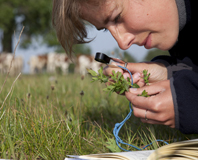Read the latest information on
Foot-and-mouth disease
 Have you ever wondered how we know that Australia doesn’t have certain pests and diseases that wreak havoc on crop production overseas?
Have you ever wondered how we know that Australia doesn’t have certain pests and diseases that wreak havoc on crop production overseas?
It’s not just because nobody has noticed anything wrong with the health of their plants.
The only way we know for sure that we don’t have certain pests is to go out looking for them where they are likely to be found.
That’s where targeted plant pest surveillance comes in. Most is carried out by state governments, but the Australian Government, peak industry bodies, environmental agencies, growers and the Australian community is also involved.
One important way in which surveillance data is used is to support access to international markets, where nil findings of particular pests are collated to provide evidence to trading partners who want assurances that they will not be importing new pests with Australian produce.
It is no longer enough to say that a pest is ‘not known to occur’, or rest on the assurance of Australia being historically free of a particular pest. We have to now say the pest is ‘known not to occur’.
Quality surveillance data is vitally important to maintain market access for produce, both interstate and overseas.
According to Stuart Kearns, Manager for Farm Biosecurity Programs at Plant Health Australia, there’s a world of difference between walking out into one of your paddocks and casually monitoring the health of your crops and livestock, and the formal surveillance that is required to say with confidence that Australia does not have certain pests or diseases.
“For that you need to decide what you are looking for, where to look, and how to look for it. You might also need a trap or lure to attract the pest so you don’t have to inspect every plant in every paddock,” Mr Kearns said.
With a list of more than 300 plant pests and diseases considered high risk to Australian productions systems, where do you start looking?
“When checking plants, you need to ensure that you look over the entire plant. Walk into the crop and pull a plant out of the ground, or take a small twig from a tree with a few leaves. Check for symptoms or the actual presence of pests or disease on the leaves and stem (and roots). Look between the leaves, leaflets and flowers for eggs or small larvae,” Mr Kearns said.
A good hand lens can also help when looking out for small insects.
It’s not all about surveillance though. Visual inspection of individual plants when monitoring a crop is also important for estimating how the crop is going in terms of average growth stage or time of year and other agronomic factors
These are just a few of the things you need to consider when devising a surveillance or monitoring strategy to go out and look for a specific pest and to show that it is not there.
Plant pest surveillance data is highly valuable because it underpins many other aspects of the biosecurity system. These include:
General surveillance programs raise awareness about pests with growers and the wider community and rely on people to look for and report anything unusual that they find during their day-to-day activities.
“This can be difficult, because some pests and diseases look similar to those that we already have in Australia. That’s why it’s important to be familiar with the pests that commonly affect your crop or are found in your region, so that you can tell if the see something different’” Mr Kearns said.
If you do see anything unusual when you are out and about, it might be new the region or even new to Australia. Please call the Plant Pest Hotline on 1800 084 881 or the Emergency Animal Disease Hotline on 1800 675 888 and report what you have seen.
